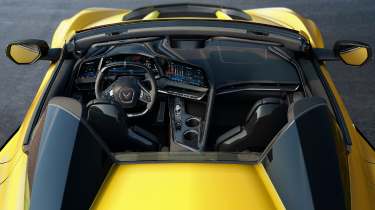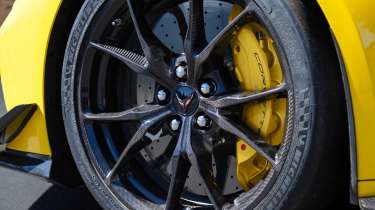Updated 2026 Chevrolet Corvette fixes one of the C8’s biggest flaws
Chevrolet has significantly updated the interior of the Corvette, with a more conventional ergonomic layout and updated tech with a new Performance App

Chevrolet has revealed extensive changes to the C8 Corvette for 2026, which will span the entire range from the Stingray to the new ZR1. While this isn’t a facelift – nothing has changed on the outside or mechanically – those familiar with the existing C8 will find a very different car upon stepping into a MY26 model.
The changes will either be very good or very bad, depending on which side of the fence you fell on when it came to the original’s controversial cabin. A highly driver-focused cockpit, the main element that really esconced the driver and separated them from their passenger, was the so-called ‘wall’ of buttons, which had the climate controls for both the driver’s and passenger’s side stacked vertically. In the first ever mid-engined Corvette and the first not offered with a manual transmission, it’s strange, looking back, that this button arrangement was almost the most controversial thing about it. It was certainly distinctive, regardless of how you felt about it.

While the stack itself remains, the buttons have been removed, with the primary climate controls now located in a more conventional, horizontal location, under the main infotainment screen. There are noticeably fewer of them though, which speaks to the fact that some of the previous button functions have moved into the digital realm. It’s not a wholesale digitisation – this isn’t a Mk8 Golf-tier disaster. Per Disty Smith, performance driving product manager, ‘there’s an intentional balance of physical and virtual controls,’ but pixel creep is pixel creep.
> Chevrolet Corvette C8 Z06 review – the American 911 GT3?
On the plus side, potential defectors from the Porsche 911, who are used to Germanic common sense and uniformity, won’t be quite so horrified upon sliding into a 26MY C8 Corvette as they would have been the previous car. The driver’s and infotainment display are now larger too – 14-inches the former and 12.7-inches the latter – while a wireless phone charger now features, located below the climate controls.
Speaking of pixel creep, the Corvette’s is now a three-screen interior, with a small 6.6-inch auxiliary panel that’s been tacked on to the outside of the driver’s binnacle. In the E-Ray, this can show info on battery status and axle power output, while on the ZR1, it can be a nice big glitzy boost gauge. It can also show tyre pressures and other performance and dynamics-related information. This is a development of the Performance App, which first debuted on the E-Ray, that’s now been expanded for relevance across the range. There’s also a G-force gauge option and an acceleration timer.

Look away from the screens and you’ll see, if it’s optioned, an electrochromic roof, allowing the driver to decide the level of tint. Other nominal changes to the Corvette lineup include the addition of Roswell Green and Blade Silver to the colour palette, as well as the option of an asymmetrical interior, with a red driver’s area, including seat, contrasted with a black passenger area. Other asymmetrical colour options are available too.
Nothing mechanical is changing for the Corvette range in 2026, though the big brake kit has been confirmed for the ZR1 ZTK package – this brings ten-piston front and six-piston rear calipers clamping carbon ceramic discs that are ‘the largest ever fitted to a production Corvette.’ For reference, the Z06 comes standard with 380mm (front) and 370mm (rear) discs. The Z07 package on the Z06 features 398mm (front) and 391mm (rear) brake discs, while the standard ZR1 has 400mm (front) and 390mm (rear) ceramic items.





